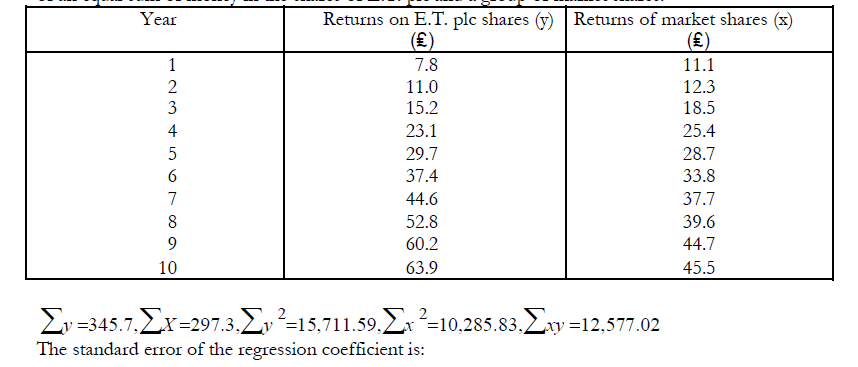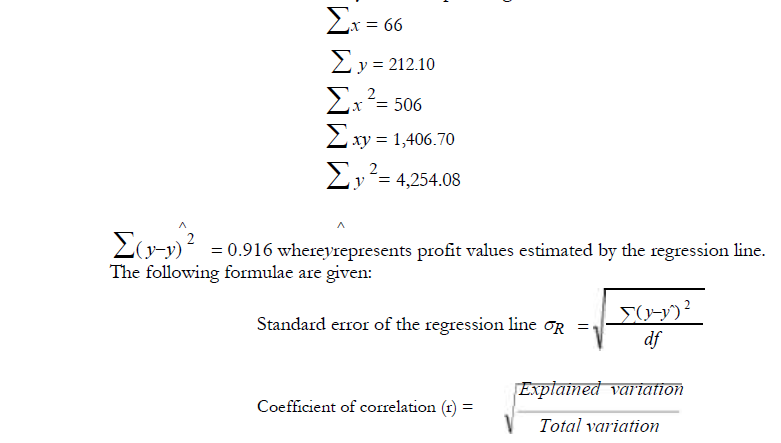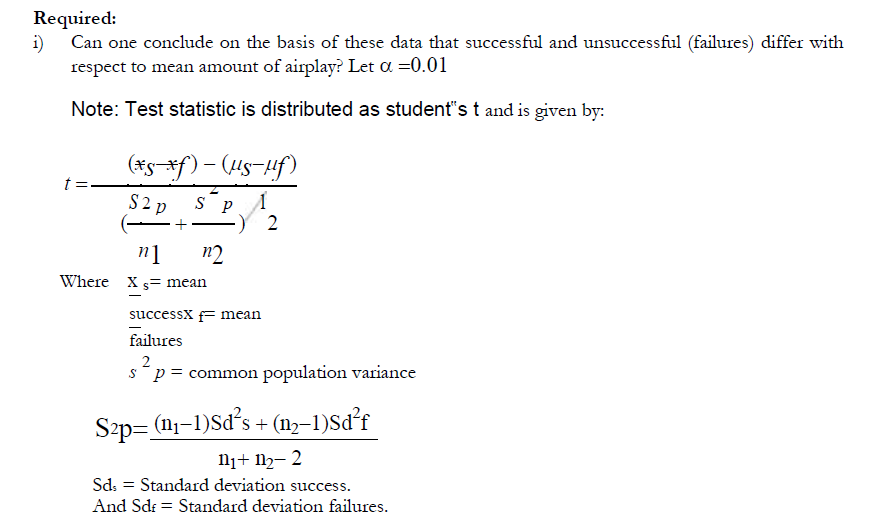 Get premium membership
Get premium membership and access questions with answers, video lessons as well as revision papers.

The regression line will be:
i) ITEt=-52.59-0.20PRt-1.48PROBt
ii) For any coefficient of the independent variables that is above the t value at o.o5 significance level is
eliminated.
Note: This should not be followed as a rule generally. Here it has been used since there in no
much information about the standard error of regression and the correlation coefficient. Otherwise
the main aim is to include the variables that give the least standard error and highest coefficient of
determination.
iii) The –52.59 constant term indicates that people usually pay up their taxes without evading. The
33.44 coefficient of true income indicated that people would tend to evade tax more when their
income is increased. The –1.48 coefficient of probability of detection indicates that people will tend
to reduce evasion when they realize there are higher probabilities of being detected.
iv) From the regression results, it is true, that it had a negative influence on income tax evasion.
raphael answered the question on January 10, 2019 at 12:18
- Briefly but clearly, explain the difference, if any, between regression analysis and correlation analysis.(Solved)
Briefly but clearly, explain the difference, if any, between regression analysis and correlation analysis.
Date posted: January 10, 2019. Answers (1)
- Kenya Graduate School (KGS) offers a variety of graduate courses. However, its main emphasis has been on
information science (IS) courses. Due to the laboratory equipment...(Solved)
Kenya Graduate School (KGS) offers a variety of graduate courses. However, its main emphasis has been on
information science (IS) courses. Due to the laboratory equipment requirements for IS courses, KGS has to
estimate in advance the expected students enrolments. Over the last 5 years, the students enrolments, by
quarter, has been:

Required:
a) Determine the estimates, by quarter, for year 1996. Justify the method you use.
b) If linear multiple regression were to be used in order to determine the predicting equation, what other
variables would be included?
c) How would the expected enrolments be compared to the actual enrolments?

Date posted: January 10, 2019. Answers (1)
- In recent years environmentalists and health professionals have been concerned about the ill effects onthe environment of the widespread use of insecticides. If human beings...(Solved)
In recent years environmentalists and health professionals have been concerned about the ill effects on
the environment of the widespread use of insecticides. If human beings are to cope with the problem
and make decisions about how to deal with it, they must understand the effect of insecticides on humans
and other animals. In the kind of study often done to promote such understanding, two professors at
University of Nairobi investigated the effect of a commonly used insecticide on sheep. Among other
statistical analyses, they derived the following linear regression equation (n = 16):

This equation describes the relationship between the activity of a certain enzyme in the
sheep's brain (Y)and the time (in hours) after the sheep has been exposed to the insecticide (X).
Required:
i) Suppose 30 hours have elapsed since a sheep has been exposed to the insecticide, what is the
predicted value of Y?
ii) How would you describe the relationship between the two variables?
iii) The professors computed a coefficient of determination (r2) of 0.86 from the data. What
conclusion can be drawn about the true relationship between the two variables?
iv) What assumption are necessary to solve part (iii) above?
Date posted: January 1, 2019. Answers (1)
- Does a high correlation mean that one variable causes another variable to vary?(Solved)
Does a high correlation mean that one variable causes another variable to vary?
Date posted: January 1, 2019. Answers (1)
- Does finding a no linear relationship between two variables mean no relationship?(Solved)
Does finding a no linear relationship between two variables mean no relationship?
Date posted: January 1, 2019. Answers (1)
- The following regression equation was calculated for class of 24 CPA II students.
Required:
a) Calculate the t ratio and the 95% confidence interval for each regression...(Solved)
The following regression equation was calculated for class of 24 CPA II students.

Standard error (0.0190) (0.034) (0.018)
Where y=students score on a theory examination
x1 = Students rank (from the bottom) in high
school x2 = Students verbal aptitude score
x3 =A measure of students character
Required:
a) Calculate the t ratio and the 95% confidence interval for each regression coefficient.
b) What assumptions did you make in (a) above? How reasonable are they?
c) Which regressor gives the strongest evidence of being statistically discernible?
d) In writing up a final regression equation, should one keep the first regressor in the equation, or drop if?
Why?
Date posted: January 1, 2019. Answers (1)
- The following data have been collected relating to returns which would have been earned from an investment
of an equal sum of money in the shares...(Solved)
The following data have been collected relating to returns which would have been earned from an investment
of an equal sum of money in the shares of E.T. plc and a group of market shares:


You are required to:
a) Plot the original data on a graph, calculate the least squares regression of y on x and draw the regression
line on the graph;
b) Test the significance of the slope of the line at the 5% level;
c) Discuss the outcomes of (a) and (b) in the context of a comparison of the two investments
Date posted: December 14, 2018. Answers (1)
- Unlisted plc hopes to achieve a Stock Market quotation for its shares. A profit forecast is necessary and, in order to achieve such a forecast,...(Solved)
Unlisted plc hopes to achieve a Stock Market quotation for its shares. A profit forecast is necessary and, in order to achieve such a forecast, the company has experimented with a number of approaches. The following are details from a linear regression on the last 11 years profit figures:
x = years (expressed 1 to 11)
y = annual profit figures

You are required:
a) To obtain the simple least squares regression line of Y on X;
b) To use the line to estimate profit in each of the next two years;
c) To calculate the coefficient of determination for the line and to explain its meaning;
d) To calculate the standard error of the regression line and to use this to obtain the 95% confidence
interval for the line;
e) On the basis of the information given on your answer (a) to (d) to determine whether it is likely that the regression line will be a good estimator of profit.
Date posted: December 14, 2018. Answers (1)
- Because of economic conditions, a firm reports that 30 per cent of its accounts receivable from other
business firms are overdue. The firm's policy is that...(Solved)
Because of economic conditions, a firm reports that 30 per cent of its accounts receivable from other
business firms are overdue. The firm's policy is that if an accountant takes a random sample of five such accounts and finds that exactly 20 per cent of the accounts are overdue 10 per cent of the time, then a warning letter should be written to the particular firm.
Required:
Should the warning letter be written?
Date posted: December 14, 2018. Answers (1)
- Mia Shillings Department Stores has compiled the following data concerning its daily sales. The sales of
each day of the week are normally distributed with the...(Solved)
Mia Shillings Department Stores has compiled the following data concerning its daily sales. The sales of
each day of the week are normally distributed with the following parameters.

Required:
Which day of the week has the lowest probability that the store will sell between Sh.110,000 and
Sh.150,000 worth of goods?
Date posted: December 14, 2018. Answers (1)
- Mia Shillings Department Stores is planning to open a store in Westlands. It has asked the Superior
Marketing Company (SMC) to do a market study of...(Solved)
Mia Shillings Department Stores is planning to open a store in Westlands. It has asked the Superior
Marketing Company (SMC) to do a market study of randomly selected families within a five-kilometer
radius of the store. Among the questions it wishes SMC to ask each home owner are:
i) family income,
ii) family size,
iii) distance from home to the store site, and
iv) whether the family owns a dog or a cat.
Required:
For each of the four questions, develop a random variable of interest to Mia Shillings Department
Stores. Denote which of these are discrete and which are continuous random variables.
Date posted: December 14, 2018. Answers (1)
- What do confidence limits measure?(Solved)
What do confidence limits measure?
Date posted: December 14, 2018. Answers (1)
- Under what conditions can the normal distribution be used as an approximation to the binomial
distribution?(Solved)
Under what conditions can the normal distribution be used as an approximation to the binomial distribution?
Date posted: December 14, 2018. Answers (1)
- Give some examples of the type of data that form a normal distribution(Solved)
Give some examples of the type of data that form a normal distribution.
Date posted: December 14, 2018. Answers (1)
- A manager is convinced that a new type of machine does not affect production at the
company's major shop floor. In order to test this, 12...(Solved)
A manager is convinced that a new type of machine does not affect production at the
company's major shop floor. In order to test this, 12 samples of this week's hourly output is
taken and the average production per hour is measured as 1158 with a standard deviation of 71. The
output per hour averaged 1196 before the machine was introduced.
Required:
Test the manager's conviction
Date posted: December 14, 2018. Answers (1)
- Prior to an advertising campaign, 35 per cent of a sample of 400 housewives used a certain product.
After the campaign, 40 per cent of a...(Solved)
Prior to an advertising campaign, 35 per cent of a sample of 400 housewives used a certain product.
After the campaign, 40 per cent of a second sample of 400 housewives used the same product.
Required:
Did the campaign increase sales?
Date posted: December 14, 2018. Answers (1)
- Two researchers in marketing, Catherine Mbugua and George Otieno, reviewed the theory of product
life cycle with respect to a specific product. They conducted a research...(Solved)
Two researchers in marketing, Catherine Mbugua and George Otieno, reviewed the theory of product
life cycle with respect to a specific product. They conducted a research project to determine the
applicability of the theory to popular music records. As part of the study, they collected extensive
information on a sample of 12 music records judged on the basis of certain well-defined criteria to be successes and a sample of 10 music records to be failures. They collected data on each music record for
a period of 16 weeks from the date the record was released to the market. One item of information they
collected on each music record was radio airplay. Measurement of this variable yielded the following
means and standard deviations for the two samples of music records.


ii) What assumptions are we making in order to use the pooled estimate of the common population
variance?
Date posted: December 14, 2018. Answers (1)
- If a Type II error is costly but a Type I error is not, why should you set the level of significance $\alpha$ at 0.10,...(Solved)
If a Type II error is costly but a Type I error is not, why should you set the level of significance $\alpha$ at 0.10, 0.20 or even higher?
Date posted: December 14, 2018. Answers (1)
- What is wrong with the following hypotheses?(Solved)
What is wrong with the following hypotheses?

Date posted: December 14, 2018. Answers (1)
- What is a one-sided confidence interval? When is it necessary?(Solved)
What is a one-sided confidence interval? When is it necessary?
Date posted: December 14, 2018. Answers (1)